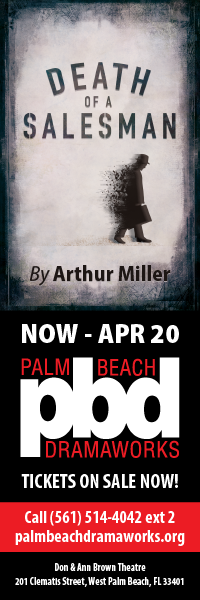 By Bill Hirschman
By Bill Hirschman
If the phrase “concert staging of a musical” summons up images of actors standing in front of music stands like statues singing a score as if it was a sterile oratorio, then Palm Beach Dramaworks’ stirring and ultimately moving production of Man of La Mancha will annihilate your expectations.
Beautifully sung, passionately acted and staged with as much movement and business as anyone can ask of a limited rehearsal period, this edition mines much of the beauty and heart from one of the most glorious scores and emotionally-affecting scripts in American musical theater.
This stripped-down creation headed by director Clive Cholerton and musical director Caryl Ginsburg Fantel is so effective that you yearn to see the even deeper, polished multi-leveled show that just one more week’s rehearsal and more opulent production values would yield.
But you’ll likely be more than satisfied with this mounting of the 1965 Tony-winning musical that plays for the next two weeks as part of Dramaworks’ Musical Theatre Masters series.
It’s hard to imagine how much better William Michals could be in his creation of Miguel de Cervantes as he acts out his novel-in-progress Don Quixote for a dungeon full of fellow prisoners awaiting trial by the Inquisition.
Michals’ full-bodied baritone reverberated musically but also limned the fervor in the lyrics. Yes, as expected, he nailed the anthem “The Impossible Dream,” underscoring the pure joy of someone who truly believes that the pursuit of ideals is the ultimate reason for existence, not the winning or losing. But when ardor flowed out of his mouth in the paean “Dulcinea,” time and respiration stopped in the theater. His eyes blazed with a younger man’s passion even underneath Quixote’s mop of unruly white hair, drooping moustache, untamed eyebrows and long beard that split into two tufts.
A key asset was that most of the cast had memorized their songs and most of their dialogue. They were freed from those music stands much of the time, allowed to roam the stage, focusing on acting the guts of the piece rather than simply reading words off a page. The importance of this cannot be overstated in how it resulted in a vibrant evening of theater as opposed to a skilled recital.
Cholerton, who said he has never seen a production of the show, has made the absolute most of that opportunity. Characters flow across the stage. A small turntable, although a bit clunky when actors twirl it around, is used by Cholerton to communicate a smooth change of scene. He injects scores of inventive bits of business such as a woman playing the barber whose shaving basin Don Quixote liberates, or Quixote’s body trembling when he makes his aged body kneel. Our favorite occurred when Aldonza gives Sancho a kitchen rag to serve as the knight’s precious token; she wipes her armpits and spits in it before handing it over.
He also has assembled a solid cast beginning with Alix Paige who recently played Aldonza in Connecticut opposite Terrence Mann. More slender and sharp-faced than many of her predecessors, she brings a world-beaten air as well as a lovely singing voice, especially to a moving rendition of “What Does He See In Me.” As an actress, she as much as anyone could use a few more days rehearsal to make credible Aldonza’s unlikely transformation.
Cholerton also requires the performers not simply retreat to chairs in the back until their next scene arrived. As Aldonza is singing her lament, Quixote and Sancho – in near darkness – are clearly paying close attention in character.
Oscar Cheda, a regional favorite, was appropriately affable, adoring and appealing as Sancho. Doubling in several parts were Ken Clement as the Innkeeper, Barry J. Tarallo as the Padre, Nick Duckart as the head muleteer, Rodrigo de la Rosa as Dr. Carrasco, along with Leah Sessa, Cassandra Zepeda and Joshua Grosso.
There are a few complaints. The entire affair, especially the music, moves at too quick a pace like a freight train rattling through a crossing. That makes it difficult for singers to land some of their lyrics and to make the emotional transitions convincing. Further, the book has levels that could use a little more development, such as the menacing venality of the prisoners, their childlike participation once enlisted in the charade, and finally their transformation having glimpsed their own potential for humanity. The last two scenes seemed a little ragged compared to the rest of the piece, but the finale is so brilliantly constructed that it borders on foolproof; the audience is nearly guaranteed to leave uplifted with hope for the future, quite a feat in the 21st Century.
Fantel does a solid job leading a three-piece combo of her piano, Greg Chance’s Spanish guitar and the precision percussion of Roy Fantel. But anyone familiar with a cast recording is really going to miss the full sound of the original orchestrations swelling with brass fanfares. The upside is that it allows the quality of the performers’ voices to be showcased.
In keeping with the vision that this is more than a concert, Dramaworks put its staff to add some bare bones touches enhancing the experience such as the aforementioned turntable, Sean Lawson’s scene-setting projections resembling Van Gogh in Arles, simple costumes including a leather and studded breastplate for Quixote courtesy of Brian O’Keefe, and lighting by Michael Burris.
It’s the second entry in the Dramaworks’ series, following Camelot in January and to be joined in August 7-18 by Stephen Sondheim’s masterpiece Company. The just announced cast stars Quinn VanAntwerp, who made his Broadway debut in 2011 as Bob Gaudio in Jersey Boys after performing the role on the road for three years, as Bobby. His group of friends and girlfriends will include: Laura Hodos, Barry Tarallo, Maribeth Graham, Wayne LeGette, Alexandra Hale, Nick Duckart, Katherine Amadeo, Leah Sessa and Natalia Coego.
A few odds and ends about the musical itself:
First produced at the then fledgling Goodspeed Opera House in Connecticut in 1965, it resonated with audiences’ consciousness at a crucial time in the country’s zeitgeist: two years after the Kennedy assassination torpedoed the dream of Camelot, in the midst of the Civil Rights struggle and just as the country was becoming embroiled in what would become a divisive war in Southeast Asia.
Bookwriter Dale Wasserman had no interest in adapting Don Quixote itself. Instead, he saw in Cervantes a fascinating story about the nobility inherent in Mankind pointedly set against an increasingly pessimistic and dark era. Challenged by a realist to see life as it is, the character Cervantes counters that he has viscerally experienced the evils of the world, and concludes, “When life itself seems lunatic, who knows where madness lies? Perhaps to be too practical is madness. To surrender dreams – this may be madness. To seek treasure where there is only trash. Too much sanity may be madness. And maddest of all, to see life as it is and not as it should be.”
Winner of five Tony Awards in 1966 and revived four times on Broadway, the frequently produced musical somehow survives almost every production in less talented hands – a testament to the strength of the work.
It’s unusual because none of the original core creators other than director Albert Marre had any Broadway experience. Wasserman was an experienced TV scriptwriter, but this was a different medium. Original lyricist W.H. Auden, the famed poet, turned in lyrics too astringent for the piece and the team turned to the equally untested Joe Darion. Mitch Leigh, who admitted he could not play an instrument, owned a stable of advertising jingle firm composers (“Nobody Doesn’t Like Sara Lee.”) La Mancha was his first and only hit, followed by a string of failures that he produced with his own money.
But the work they created spoke so directly to the spirit that La Mancha is perpetually on stage somewhere in regional theaters, community theaters or high school drama clubs – and the work is so sturdy that is has triumphed over most ham-handed productions other than the disastrous film in 1972. That cratered because it failed to realize that La Mancha is a specifically theatrical creature that requires the active buy-in of an audience’s heart and imagination.
The original production did not bow on Broadway. With no Main Stem theater free at the time, La Mancha initially opened in Greenwich Village on a thrust stage at the ANTA Washington Square Theatre, a makeshift barn serving as a temporary home to Ellis Rabb’s Broadway rep company until Lincoln Center was completed. But even before it moved uptown to the Martin Beck (now Hirschfeld), some loophole in the rules made it eligible for the Tony Awards it won including best musical, best score, best director and best actor.
It cemented the stage career of former romantic lead Richard Kiley (Kismet, No Strings). It was one of the last successes for Joan Diener, a fiery soprano with a three to four-octave range and who married Marre after they met in Kismet. Although he worked afterward, La Mancha was one of the last major stage successes for Jack Cole, who is still credited more than Bob Fosse and Jerome Robbins with creating the fusion of modern dance with Broadway hoofing. The Spanish peasant Sancho was portrayed by the old Yiddish theater stalwart and vaudevillian Irving Jacobson.
Man of La Mancha runs through July 21 at Palm Beach Dramaworks, the Don & Ann Brown Theatre, 201 Clematis St., West Palm Beach. Performances 8 p.m. Wednesday-Saturday, 2 p.m. Saturday and Sunday. Running time 2 hours including one intermission. Tickets are $35. Call (561) 514-4042, ext. 2, or visit www.palmbeachdramaworks.org.







 A PaperStreet Web Design
A PaperStreet Web Design
